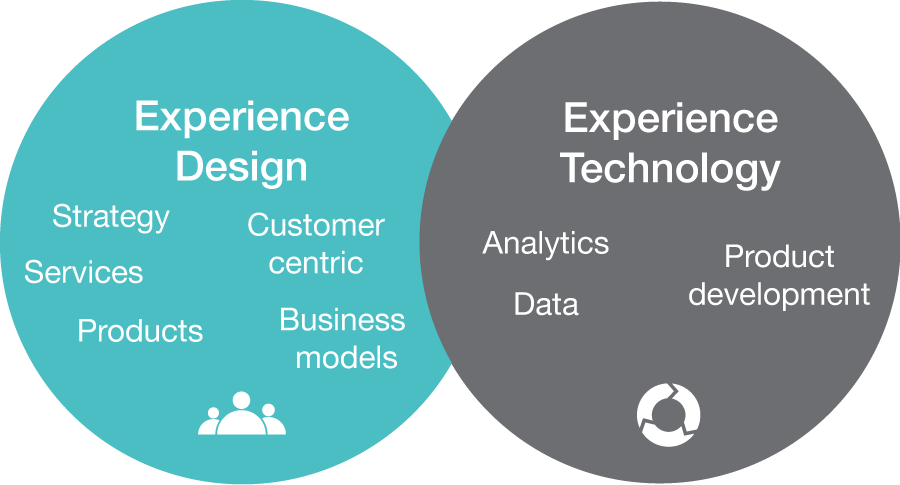-
-
-
-
URL copied!
Digital transformation: everybody’s talking about it, but few agree on what it means. Is it traditional brick-and-mortar businesses and industries learning how to do business on the web? Is it innovating digitally first, developing products and services for a new generation that expects to be met wherever they are, on any device? Is it both of those things, or even more? The fact is that it takes working with digital transformation for some time in order to really understand it. Once you have, you can say that you’re “thinking digital.”
A number of market forces are making it necessary for business of all sizes to think about digital transformation. They’re having to re-evaluate everything from strategy to business models, taking into account customer engagement, product relevance, and brand differentiation. Integrating these concerns is essential for thinking digital, and requires a holistic framework for continuous insight and delivery.

Experience design helps define part of such a framework. One of the cornerstones of thinking digital is customer centricity: what are your customers doing at each stage of their journey through an experience? Equally important are the myriad channels through which a customer now encounters your experience: from handheld devices to wearables, the number of touch points has exploded.
Rapidly evolving experience technologies enable your experiences and form an equally important part of your digital transformation framework From big data technologies to advanced analytics and machine learning, companies have never had such powerful tools at their disposal to create highly branded, differentiated experiences. Powerful new insight techniques—including ethnography and open innovation—help advance these technologies into novel and engaging applications. And new product development models, including Minimum Viable Product (MVP), enable rapid iteration of products and experiences, which can now be customized on the fly.
Extensive experience with digital transformation has shown that thinking digital finally takes hold when experience design and experience technologies align to create competitive value. In this new way of working, companies understand a customer’s need, create a new or improved experience that meets the need, and eliminate friction along the way.
Ready to take an integrated approach toward digital transformation? Read this GlobalLogic white paper and learn more about the emergent strategy that allows companies to deliver greater customer value with greater speed in a digitally transforming world.
Top Insights
Best practices for selecting a software engineering partner
SecurityDigital TransformationDevOpsCloudMediaMy Intro to the Amazing Partnership Between the...
Experience DesignPerspectiveCommunicationsMediaTechnologyAdaptive and Intuitive Design: Disrupting Sports Broadcasting
Experience DesignSecurityMobilityDigital TransformationCloudBig Data & AnalyticsMedia
Let’s Work Together
Related Content
Enterprise GenAI: The Time to Focus on High-ROI Use Cases is Now
In the relentless pursuit of digital transformation, enterprises are constantly seeking innovative avenues to maintain a competitive edge. Generative Artificial Intelligence (GenAI) stands out as one of the most promising frontiers in this quest. Unlike traditional AI, which primarily focuses on data analysis and interpretation, GenAI has the unique ability to generate new, original content, ideas, and solutions, making it an indispensable tool for businesses across various sectors.
Learn More
Virtual Health Assistant – Transforming Value Based Care
Digital virtual health assistant, also known as virtual health care assistants, are digital platforms that use artificial intelligence (AI) technology to assist individuals manage their health and wellness. These virtual assistants use natural language processing, machine learning and other AI powered technologies to provide a wide range of services.
Learn More
Smartphone on Wheels
Over the past decade, cars have undergone a significant transformation to provide a more connected experience for drivers. Cars are connected to the surroundings more than ever. There are ways to make payments for gas right from the infotainment system. A lot of sensors in cars can detect its health and provide information with predictive … Continue reading Thinking Digital: A New Way of Thinking About Digital Transformation →
Learn More
Industry Clouds – Fad or Future
Enterprises in every industry are embarking on digital transformation by moving their legacy systems and applications to Cloud. Cloud has become the enabler for digital transformation. But, the generic cloud capabilities provided by hyperscalers do not meet the specific needs of each industry in terms of performance, cost effectiveness, regulatory compliance and efficiency. This has … Continue reading Thinking Digital: A New Way of Thinking About Digital Transformation →
Learn More
If You Build Products, You Should Be Using Digital Twins
Digital twin technology is one of the fastest growing concepts of Industry 4.0. In the simplest terms, a digital twin is a virtual replica of a real-world object that is run in a simulation environment to test its performance and efficacy
Learn More
Share this page:
-
-
-
-
URL copied!